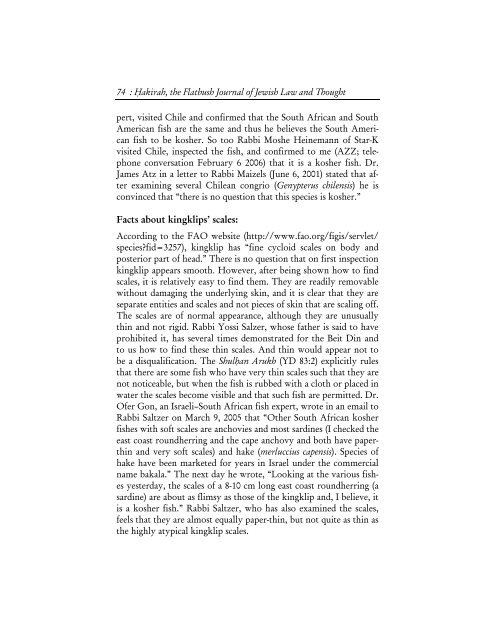The Kashrut of Kingklip: Its Turbulent History and Who ... - Hakirah
The Kashrut of Kingklip: Its Turbulent History and Who ... - Hakirah
The Kashrut of Kingklip: Its Turbulent History and Who ... - Hakirah
You also want an ePaper? Increase the reach of your titles
YUMPU automatically turns print PDFs into web optimized ePapers that Google loves.
74 : Hạkirah, the Flatbush Journal <strong>of</strong> Jewish Law <strong>and</strong> Thought<br />
pert, visited Chile <strong>and</strong> confirmed that the South African <strong>and</strong> South<br />
American fish are the same <strong>and</strong> thus he believes the South American<br />
fish to be kosher. So too Rabbi Moshe Heinemann <strong>of</strong> Star-K<br />
visited Chile, inspected the fish, <strong>and</strong> confirmed to me (AZZ; telephone<br />
conversation February 6 2006) that it is a kosher fish. Dr.<br />
James Atz in a letter to Rabbi Maizels (June 6, 2001) stated that after<br />
examining several Chilean congrio (Genypterus chilensis) he is<br />
convinced that “there is no question that this species is kosher.”<br />
Facts about kingklips’ scales:<br />
According to the FAO website (http://www.fao.org/figis/servlet/<br />
speciesfid=3257), kingklip has “fine cycloid scales on body <strong>and</strong><br />
posterior part <strong>of</strong> head.” <strong>The</strong>re is no question that on first inspection<br />
kingklip appears smooth. However, after being shown how to find<br />
scales, it is relatively easy to find them. <strong>The</strong>y are readily removable<br />
without damaging the underlying skin, <strong>and</strong> it is clear that they are<br />
separate entities <strong>and</strong> scales <strong>and</strong> not pieces <strong>of</strong> skin that are scaling <strong>of</strong>f.<br />
<strong>The</strong> scales are <strong>of</strong> normal appearance, although they are unusually<br />
thin <strong>and</strong> not rigid. Rabbi Yossi Salzer, whose father is said to have<br />
prohibited it, has several times demonstrated for the Beit Din <strong>and</strong><br />
to us how to find these thin scales. And thin would appear not to<br />
be a disqualification. <strong>The</strong> Shulhan Arukh (YD 83:2) explicitly rules<br />
that there are some fish who have very thin scales such that they are<br />
not noticeable, but when the fish is rubbed with a cloth or placed in<br />
water the scales become visible <strong>and</strong> that such fish are permitted. Dr.<br />
Ofer Gon, an Israeli–South African fish expert, wrote in an email to<br />
Rabbi Saltzer on March 9, 2005 that “Other South African kosher<br />
fishes with s<strong>of</strong>t scales are anchovies <strong>and</strong> most sardines (I checked the<br />
east coast roundherring <strong>and</strong> the cape anchovy <strong>and</strong> both have paperthin<br />
<strong>and</strong> very s<strong>of</strong>t scales) <strong>and</strong> hake (merluccius capensis). Species <strong>of</strong><br />
hake have been marketed for years in Israel under the commercial<br />
name bakala.” <strong>The</strong> next day he wrote, “Looking at the various fishes<br />
yesterday, the scales <strong>of</strong> a 8-10 cm long east coast roundherring (a<br />
sardine) are about as flimsy as those <strong>of</strong> the kingklip <strong>and</strong>, I believe, it<br />
is a kosher fish.” Rabbi Saltzer, who has also examined the scales,<br />
feels that they are almost equally paper-thin, but not quite as thin as<br />
the highly atypical kingklip scales.
















